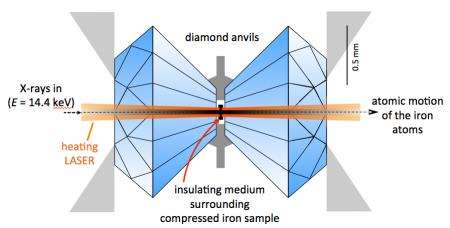An illustration shows the general features of a new melt-detection method developed by mineral physics expert Jennifer Jackson. Credit: Jennifer Jackson/Caltech
(Phys.org)—In December 2011, Caltech mineral-physics expert Jennifer Jackson reported that she and a team of researchers had used diamond-anvil cells to compress tiny samples of iron—the main element of the earth's core. By squeezing the samples to reproduce the extreme pressures felt at the core, the team was able to get a closer estimate of the melting point of iron. At the time, the measurements that the researchers made were unprecedented in detail. Now, they have taken that research one step further by adding infrared laser beams to the mix.
The lasers are a source of heat that, when sent through the compressed iron samples, warm them up to the point of melting. And because the earth's core consists of a solid inner region surrounded by a liquid outer shell, the melting temperature of iron at high pressure provides an important reference point for the temperature distribution within the earth's core.
"This is the first time that anyone has combined Mössbauer spectroscopy and heating lasers to detect melting in compressed samples," says Jackson, a professor of mineral physics at Caltech and lead author of a recent paper in the journal Earth and Planetary Science Letters that outlined the team's new method. "What we found is that iron, compared to previous studies, melts at higher temperatures than what has been reported in the past."
Earlier research by other teams done at similar compressions—around 80 gigapascals—reported a range of possible melting points that topped out around 2600 Kelvin (K). Jackson's latest study indicates an iron melting point at this pressure of approximately 3025 K, suggesting that the earth's core is likely warmer than previously thought.
Knowing more about the temperature, composition, and behavior of the earth's core is essential to understanding the dynamics of the earth's interior, including the processes responsible for maintaining the earth's magnetic field. While iron makes up roughly 90 percent of the core, the rest is thought to be nickel and light elements—like silicon, sulfur, or oxygen—that are alloyed, or mixed, with the iron.
To develop and perform these experiments, Jackson worked closely with the Inelastic X-ray and Nuclear Resonant Scattering Group at the Advanced Photon Source at Argonne National Laboratory in Illinois. By laser heating the iron sample in a diamond-anvil cell and monitoring the dynamics of the iron atoms via a technique called synchrotron Mössbauer spectroscopy (SMS), the researchers were able to pinpoint a melting temperature for iron at a given pressure. The SMS signal is sensitively related to the dynamical behavior of the atoms, and can therefore detect when a group of atoms is in a molten state.
She and her team have begun experiments on iron alloys at even higher pressures, using their new approach.
"What we're working toward is a very tight constraint on the temperature of the earth's core," says Jackson. "A number of important geophysical quantities, such as the movement and expansion of materials at the base of the mantle, are dictated by the temperature of the earth's core."
"Our approach is a very elegant way to look at melting because it takes advantage of the physical principle of recoilless absorption of X-rays by nuclear resonances—the basis of the Mössbauer effect—for which Rudolf Mössbauer was awarded the Nobel Prize in Physics," says Jackson. "This particular approach to study melting has not been done at high pressures until now."
Jackson's findings not only tell us more about our own planet, but could indicate that other planets with iron-rich cores, like Mercury and Mars, may have warmer internal temperatures as well.
Her paper, "Melting of compressed iron by monitoring atomic dynamics," was published in Earth and Planetary Science Letters on January 8, 2013.
Journal information: Earth and Planetary Science Letters
Provided by California Institute of Technology





















